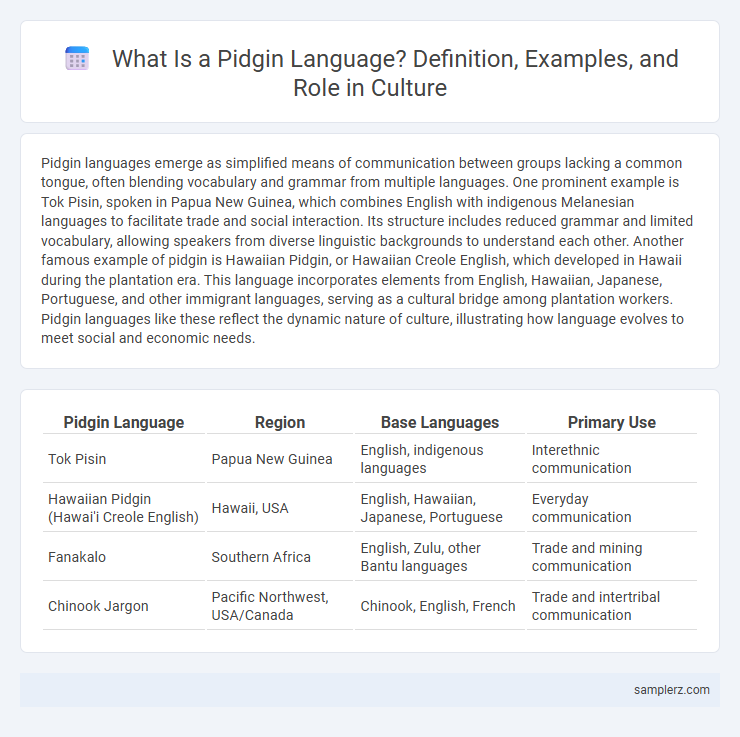Pidgin languages emerge as simplified means of communication between groups lacking a common tongue, often blending vocabulary and grammar from multiple languages. One prominent example is Tok Pisin, spoken in Papua New Guinea, which combines English with indigenous Melanesian languages to facilitate trade and social interaction. Its structure includes reduced grammar and limited vocabulary, allowing speakers from diverse linguistic backgrounds to understand each other. Another famous example of pidgin is Hawaiian Pidgin, or Hawaiian Creole English, which developed in Hawaii during the plantation era. This language incorporates elements from English, Hawaiian, Japanese, Portuguese, and other immigrant languages, serving as a cultural bridge among plantation workers. Pidgin languages like these reflect the dynamic nature of culture, illustrating how language evolves to meet social and economic needs.
Table of Comparison
| Pidgin Language | Region | Base Languages | Primary Use |
|---|---|---|---|
| Tok Pisin | Papua New Guinea | English, indigenous languages | Interethnic communication |
| Hawaiian Pidgin (Hawai'i Creole English) | Hawaii, USA | English, Hawaiian, Japanese, Portuguese | Everyday communication |
| Fanakalo | Southern Africa | English, Zulu, other Bantu languages | Trade and mining communication |
| Chinook Jargon | Pacific Northwest, USA/Canada | Chinook, English, French | Trade and intertribal communication |
Introduction to Pidgin Languages in Culture
Pidgin languages arise from the need for communication between speakers of different native tongues, often in trade, colonization, or multicultural settings. These simplified languages combine elements from multiple languages, featuring limited vocabulary and simplified grammar to facilitate basic understanding. Notable examples include Tok Pisin in Papua New Guinea and Hawaiian Pidgin, both reflecting unique cultural histories and social interactions.
Historical Origins of Pidgin Languages
Pidgin languages historically emerged as simplified means of communication between speakers of different native languages, often in trade, colonization, or plantation contexts. One notable example is Tok Pisin, which originated in Papua New Guinea during the 19th century as a blend of English and indigenous languages to facilitate trade and cooperation among diverse language groups. These languages typically develop limited vocabularies and grammatical structures, serving pragmatic communication needs rather than native fluency.
Key Features of Pidgin Languages
Pidgin languages typically emerge as simplified means of communication between speakers of different native languages, characterized by limited vocabulary and reduced grammatical structure. Key features include a lack of native speakers, reliance on a dominant language's lexicon, and grammatical simplification to facilitate basic interaction. These languages function primarily in trade, colonization, or multicultural contact zones, gradually evolving if adopted widely.
Famous Examples of Pidgin Languages Worldwide
Tok Pisin, widely spoken in Papua New Guinea, serves as a prime example of a pidgin language that evolved into a creole, blending English vocabulary with indigenous linguistic structures. Hawaiian Pidgin, or Hawai'i Creole English, emerged from the necessity of communication among diverse ethnic groups in plantations, incorporating elements of English, Hawaiian, Japanese, and Portuguese languages. West African Pidgin English, prevalent across countries like Nigeria and Ghana, functions as a lingua franca, facilitating trade and social interaction with simplified English-based grammar and vocabulary influenced by local African languages.
Tok Pisin: A Case Study in Papua New Guinea
Tok Pisin serves as a prominent example of a pidgin language, originating in Papua New Guinea as a means of communication among diverse indigenous groups. It combines English vocabulary with local linguistic structures, becoming a creole language spoken by over 4 million people. Tok Pisin plays a crucial cultural role, facilitating social integration and national identity in Papua New Guinea.
Nigerian Pidgin: Bridging Communication in West Africa
Nigerian Pidgin serves as a vital lingua franca, bridging diverse ethnic groups across Nigeria and neighboring West African countries by facilitating everyday communication. Rooted in English with influences from indigenous languages, Nigerian Pidgin embodies cultural exchange and social cohesion. Its widespread use in markets, media, and informal settings underscores its role as a dynamic tool for unity and mutual understanding in multiethnic communities.
Haitian Creole: Evolution from Pidgin to Creole
Haitian Creole originated as a pidgin language during the 17th and 18th centuries when African slaves and French colonists in Haiti needed a simplified means of communication. Over time, this pidgin expanded and stabilized into a fully developed creole with its own grammar and vocabulary, reflecting influences from French, African languages, and indigenous Taino speech. Today, Haitian Creole is one of the most widely spoken creole languages, serving as a symbol of Haitian cultural identity and linguistic resilience.
The Role of Pidgin in Global Communication
Pidgin languages, such as Tok Pisin in Papua New Guinea and Nigerian Pidgin English, serve as vital communicative bridges across diverse linguistic communities worldwide. These simplified languages enable effective trade, social interaction, and cultural exchange among people without a shared native tongue, promoting inclusivity and mutual understanding. Their role in global communication highlights the adaptability and dynamic nature of human language in connecting disparate cultures.
Cultural Significance of Pidgin Languages
Pidgin languages, such as Tok Pisin in Papua New Guinea and Hawaiian Pidgin in the United States, serve as vital cultural bridges that facilitate communication among diverse linguistic groups. These languages embody unique cultural identities by blending vocabulary and grammar from multiple original languages, reflecting historical trade, colonization, and migration patterns. The cultural significance of pidgin languages lies in their role in preserving community cohesion and enabling the expression of mixed heritage within multilingual societies.
Future of Pidgin Languages in a Globalized World
Pidgin languages, such as Tok Pisin in Papua New Guinea and Nigerian Pidgin English, illustrate linguistic adaptability and cultural fusion in diverse communities. With increasing globalization, these pidgins are evolving into creoles, gaining official recognition and media presence, which supports their preservation and growth. Technology and transnational communication platforms are accelerating the spread and standardization of pidgin languages, enhancing their role in education and cross-cultural dialogue.

example of pidgin in language Infographic
 samplerz.com
samplerz.com